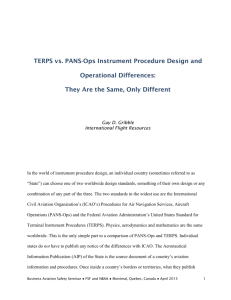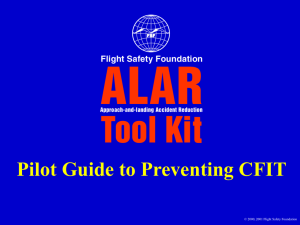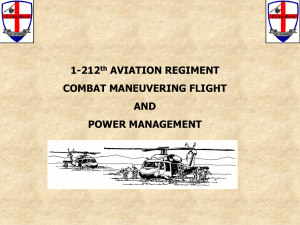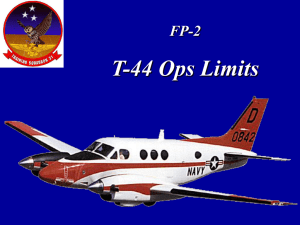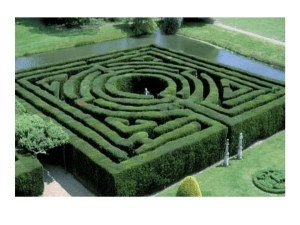TERPS vs. PANS-Ops - Flight Safety Foundation
advertisement
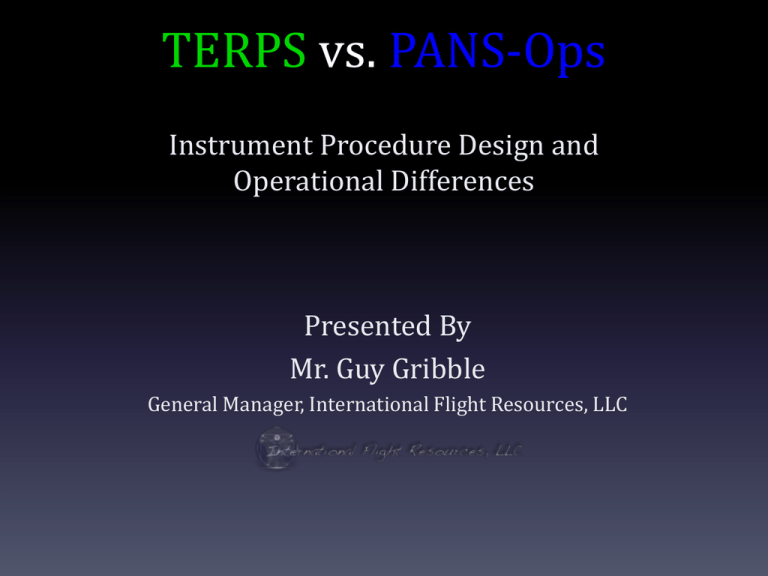
TERPS vs. PANS-Ops Instrument Procedure Design and Operational Differences Presented By Mr. Guy Gribble General Manager, International Flight Resources, LLC TERPS vs. PANS-Ops They Are The Same, Only Different Departures Holding Arrival Maneuvering Approaches Missed Approaches TERPS vs. PANS-Ops They Are The Same, Only Different Physics, Aerodynamics, Mathematics Units of Measure US Customary Units vs. Meters Conversions ? Rounding of Numbers Fix Tolerances and Accuracy Flight Technical Errors TERPS vs. PANS-Ops Who is In Charge Here ? State (Country) Aeronautical Information Publication, AIP Flight Check, Maintain Publish, Revise Design Criteria Standard design development Role of the Procedure Designer Pilot operational procedures ICAO, International Civil Aviation Organization SARPS vs. Documents TERPS vs. PANS-Ops Where Does This Data Come From ? • State (Country) • Commercial Provider • WGS-84 Compliant ? Airport Country Somewhere ? Russia China India Reproduced with permission of Jeppesen Sanderson, Inc. Not to be used for navigation. TERPS vs. PANS-Ops Standard Instrument Departure “Normal” Operations Maintain the Ground Track Maintain the Required Climb Gradient TERPS vs. Pans-Ops vs. FAR 25 Standard Instrument Departure • Vertically Speaking Departure End Of Runway DER 35 Ft ? 15? 5 M TERPS vs. PANS-Ops Standard Instrument Departure • If straight out will not work… Climb faster over obstacle Turn away from obstacle Keep in sight, “See and avoid” Climb in a safe sector away from obstacle Speed limiting Combinations of any of the above TERPS vs. PANS-Ops Standard Instrument Departure • Climb Faster Over Obstacle MSA 152 Feet per NM OCS Requires 350'/NM 48 Feet per NM ROC Until Reaching MSA 200 FEET PER NM Maintain 4.3% Until Reaching 1700MSL 35 Ft ? DER 5M MSA TERPS vs. PANS-Ops Standard Instrument Departure • Turn Away From Obstacle ≈ 2 NM Initial Climb Area ≈ 3.5 KM 15˚ Splay 500' 500' Area 1 TERPS vs. PANS-Ops Standard Instrument Departure • Turn Away From Obstacle ≈ 2 NM Initial Climb Area ≈ 3.5 KM 15˚ Splay 500' 500' Area 1 TERPS vs. PANS-Ops Standard Instrument Departure, TERPS • Keep in Sight and Tell Pilot to "See and Avoid" X Visual Climb Over Airport Hazard Beacons on Take Off Minimums top of hill to the east 800/2 clearly visible or Take Off Minimums 600/1 15˚ MAX TERPS vs. PANS-Ops Standard Instrument Departure, TERPS • Climb in a Safe Sector 25 or 46 NM Diverse Departure Evaluation No Departure Turns East 15˚ MAX X TERPS vs. PANS-Ops Standard Instrument Departure, PANS-Ops • Climb in a Safe Sector X TERPS vs. PANS-Ops Standard Instrument Departure, PANS-Ops • Climb in a Safe Sector No Turns Eastbound X TERPS vs. PANS-Ops Standard Instrument Departure • “Minimum Safe Altitude”, MSA TERPS Reproduced with permission of Jeppesen Sanderson, Inc. Not to be used for navigation. TERPS vs. PANS-Ops Standard Instrument Departure • “Minimum Sector Altitude”, MSA PANS-Ops Reproduced with permission of Jeppesen Sanderson, Inc. Not to be used for navigation. TERPS vs. PANS-Ops Standard Instrument Departure • “Minimum Safe Altitude”, MSA PANS-Ops Reproduced with permission of Jeppesen Sanderson, Inc. Not to be used for navigation. TERPS vs. PANS-Ops Holding • Timing PANS-Ops >14,000 = 1.5 Minute ≤ 14,000 = 1 Minute TERPS TERPS vs. PANS-Ops Holding • Speeds PANS-Ops >34,000 = IMN.83 >20,000 ≤ 34,000 = 265 KIAS >14,000 ≤ 20,000 = 240 KIAS ≤ 14,000 = 230 KIAS >14,000 = 240 265 >6,000≤ 14,000 = 220 KIAS 230/210KIAS ≤ 6,000 = 210 200 KIAS TERPS TERPS vs. PANS-Ops Holding • Evaluated Airspace TERPS vs. PANS-Ops Arrivals and Maneuvering Procedures X X X X X X Definitions and Use of Entry Procedures Evaluated Airspace Obstacle Clearance Speeds Selection of Turn X X X X X X TERPS vs. PANS-Ops Arrivals and Maneuvering Procedures 45/180 45/180 80/260 80/260 Teardrop Base Turn 10 NM Limit Holding In lieu of Turn point Entry Sector Racetrack TERPS vs. PANS-Ops Arrivals and Maneuvering Procedures, TERPS Entry Procedure TERPS vs. PANS-Ops Arrivals and Maneuvering Procedures, PANS-Ops Entry Sector Defined TERPS vs. PANS-Ops Arrivals and Maneuvering Procedures, PANS-Ops "Omni-Directional" Defined TERPS vs. PANS-Ops Evaluated Airspace Intermediate Segment, TERPS TERPS vs. PANS-Ops Evaluated Airspace Intermediate Segment, PANS-Ops 1 min./45-180 Procedure turn area TERPS vs. PANS-Ops Evaluated Airspace Final Segment, Non-Precision VOR = 7.8˚ SPLAY NDB = 10.3˚ SPLAY All = 14.29˚ SPLAY TERPS vs. PANS-Ops Approach Procedures 350 No Final Approach Fix 300 300 Final Approach Fix 250 200 Precision Approach 200 TERPS vs. PANS-Ops Arrivals and Maneuvering Procedures Speeds TERPS vs. PANS-Ops Arrivals and Maneuvering Procedures Speeds TERPS vs. PANS-Ops Visual Approaches and Visual Maneuvering X X X X X X Definition of Use for Evaluated Airspace OCA/ROC Speeds Visual Aids and Cues X X X X X X TERPS vs. PANS-Ops "Visual" vs. Circle-to-Land X X X X X X X Definition of Use for Evaluated Airspace OCA/ROC Speeds Visual Aids and Cues MDA vs. Descent Point X X X X X X X TERPS vs. PANS-Ops Circling Approaches and Maneuvering “C” 2.68 NM “D” 3.49 NM 1.7 NM 2.3 NM “C” 4.2 NM “D” 5.28 NM 300‘AFL 394‘AFL TERPS vs. PANS-Ops Circling Approaches and Maneuvering Pans-Ops Acft Cat Min Vis MOC/HAA Max Speed/ºAOB 2 x Radius + Straight C 2.0 NM 394/ 591 ft 180 KIAS/20º 3.70+.5 = 4.20 NM D 2.5 NM 394/ 689 ft 205 KIAS/20º 4.68+.6 = 5.28 NM TERPS Acft Cat Min Vis ROC/HAA Max Speed/ºAOB OEA Radius + Straight=CAR* C 1 ½ SM 300/ 450 ft 145 KIAS/20º 2.18+.5 = 2.68 NM D 2.0 SM 300/ 550 ft 165 KIAS/20º 2.89+.6 = 3.49 NM With Change #21 and later, At 1000’MSL, ISA Standard and 25KTS of added wind. Visibility in Statue Miles OEA= Obstacle Evaluated Area, CAR= Circling Area Radius (1.3NM Minimum) TERPS vs. PANS-Ops Circling Approaches and Maneuvering Pans-Ops Acft Cat Min Vis MOC/HAA Max Speed/ºAOB 2 x Radius + Straight C 2.0 NM 394/ 591 ft 180 KIAS/20º 3.70+.5 = 4.20 NM D 2.5 NM 394/ 689 ft 205 KIAS/20º 4.68+.6 = 5.28 NM TERPS Acft Cat Min Vis ROC/HAA Max Speed/ºAOB OEA Radius + Straight=CAR* C 1 ½ SM 300/ 450 ft 145 KIAS/20º 2.18+.5 = 2.68 NM D 2.0 SM 300/ 550 ft 165 KIAS/20º 2.89+.6 = 3.49 NM With Change #21 and later, At 1000’MSL, ISA Standard and 25KTS of added wind. Visibility in Statue Miles OEA= Obstacle Evaluated Area, CAR= Circling Area Radius (1.3NM Minimum) TERPS vs. PANS-Ops Circling Approaches and Maneuvering Pans-Ops Acft Cat Min Vis MOC/HAA Max Speed/ºAOB 2 x Radius + Straight C 2.0 NM 394/ 591 ft 180 KIAS/20º 3.70+.5 = 4.20 NM D 2.5 NM 394/ 689 ft 205 KIAS/20º 4.68+.6 = 5.28 NM TERPS Acft Cat Min Vis ROC/HAA Max Speed/ºAOB OEA Radius + Straight=CAR* C 1 ½ SM 300/ 450 ft 145 KIAS/20º 2.18+.5 = 2.68 NM D 2.0 SM 300/ 550 ft 165 KIAS/20º 2.89+.6 = 3.49 NM With Change #21 and later, At 1000’MSL, ISA Standard and 25KTS of added wind. Visibility in Statue Miles OEA= Obstacle Evaluated Area, CAR= Circling Area Radius (1.3NM Minimum) TERPS vs. PANS-Ops Circling Approaches and Maneuvering Pans-Ops Acft Cat Min Vis MOC/HAA Max Speed/ºAOB 2 x Radius + Straight C 2.0 NM 394/ 591 ft 180 KIAS/20º 3.70+.5 = 4.20 NM D 2.5 NM 394/ 689 ft 205 KIAS/20º 4.68+.6 = 5.28 NM TERPS Acft Cat Min Vis ROC/HAA Max Speed/ºAOB OEA Radius + Straight=CAR* C 1 ½ SM 300/ 450 ft 145 KIAS/20º 2.18+.5 = 2.68 NM D 2.0 SM 300/ 550 ft 165 KIAS/20º 2.89+.6 = 3.49 NM With Change #21 and later, At 1000’MSL, ISA Standard and 25KTS of added wind. Visibility in Statue Miles OEA= Obstacle Evaluated Area, CAR= Circling Area Radius (1.3NM Minimum) TERPS vs. PANS-Ops Circling Approaches and Maneuvering Pans-Ops Acft Cat Min Vis MOC/HAA Max Speed/ºAOB 2 x Radius + Straight C 2.0 NM 394/ 591 ft 180 KIAS/20º 3.70+.5 = 4.20 NM D 2.5 NM 394/ 689 ft 205 KIAS/20º 4.68+.6 = 5.28 NM TERPS Acft Cat Min Vis ROC/HAA Max Speed/ºAOB OEA Radius + Straight=CAR* C 1 ½ SM 300/ 450 ft 145 KIAS/20º 2.18+.5 = 2.68 NM D 2.0 SM 300/ 550 ft 165 KIAS/20º 2.89+.6 = 3.49 NM With Change #21 and later, At 1000’MSL, ISA Standard and 25KTS of added wind. Visibility in Statue Miles OEA= Obstacle Evaluated Area, CAR= Circling Area Radius (1.3NM Minimum) TERPS vs. PANS-Ops Circling Approaches and Maneuvering Pans-Ops Acft Cat Min Vis MOC/HAA Max Speed/ºAOB 2 x Radius + Straight C 2.0 NM 394/ 591 ft 180 KIAS/20º 3.70+.5 = 4.20 NM D 2.5 NM 394/ 689 ft 205 KIAS/20º 4.68+.6 = 5.28 NM TERPS Acft Cat Min Vis ROC/HAA Max Speed/ºAOB OEA Radius + Straight=CAR* C 1 ½ SM 300/ 450 ft 145 KIAS/20º 2.18+.5 = 2.68 NM D 2.0 SM 300/ 550 ft 165 KIAS/20º 2.89+.6 = 3.49 NM With Change #21 and later, At 1000’MSL, ISA Standard and 25KTS of added wind. Visibility in Statue Miles OEA= Obstacle Evaluated Area, CAR= Circling Area Radius (1.3NM Minimum) Reproduced with permission of Jeppesen Sanderson, Inc. Not to be used for navigation. Reproduced with permission of Jeppesen Sanderson, Inc. Not to be used for navigation. Reproduced with permission of Jeppesen Sanderson, Inc. Not to be used for navigation. Greece South Korea Japan Canada Mexico Venezuela Azores Germany Saudi Arabia TERPS vs. PANS-Ops Missed Approach Procedures Intermediate Missed Approach TERPS vs. PANS-Ops Missed Approach Procedures Intermediate Missed Approach TERPS vs. PANS-Ops Instrument Procedure Design and Operational Differences Presented By Mr. Guy Gribble General Manager, International Flight Resources, LLC www.InternationalFlightResources.com
